Keyword cost is the amount you pay to the ad platform (like Google Ads) every time someone clicks your ad. It’s often referred to as the cost per click (CPC).
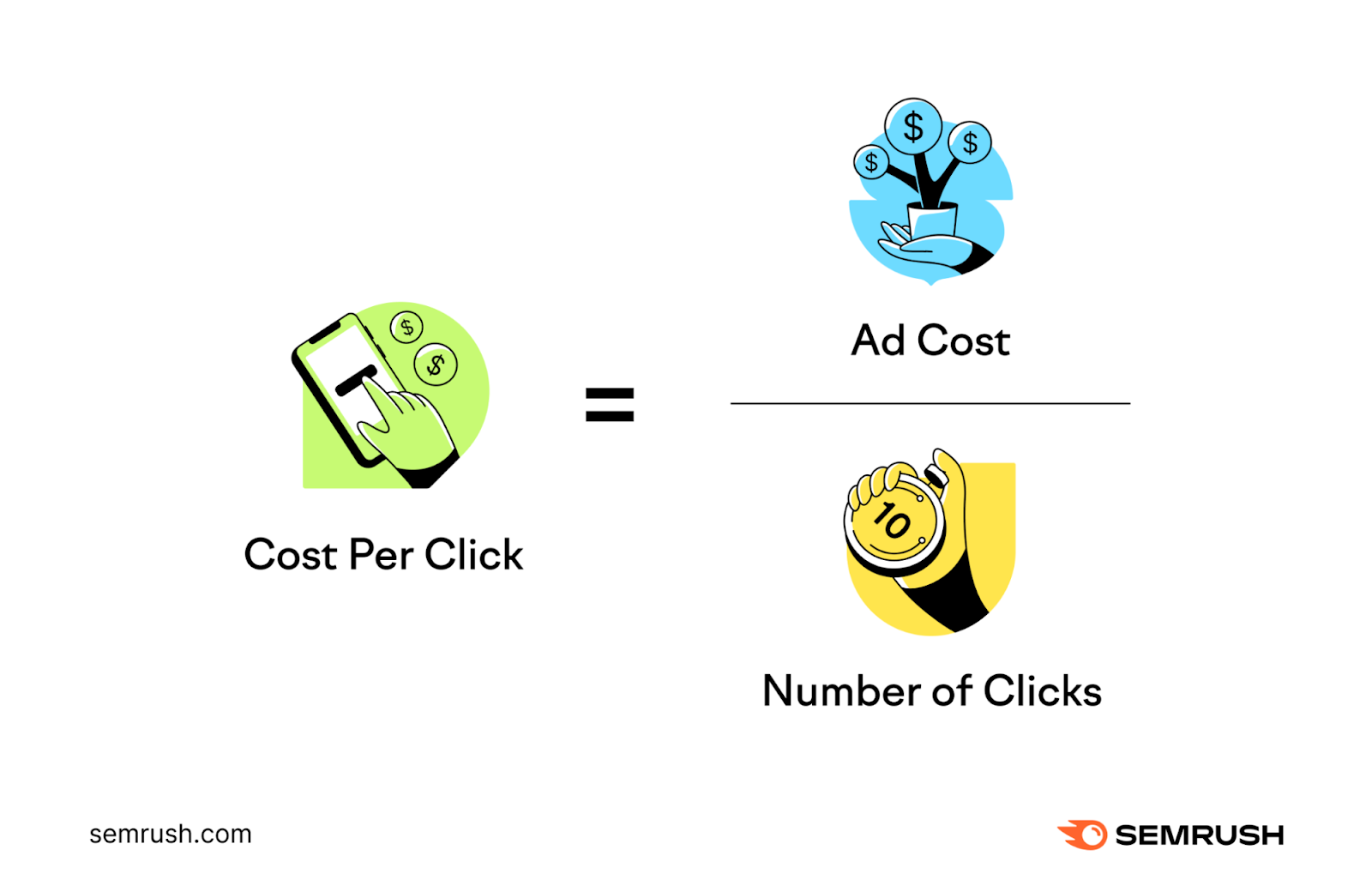
Knowing the price of keywords you’re targeting helps you:
- Manage your ad campaign budget effectively
- Optimize the campaign’s overall performance
In this article, we’ll discuss how you can find out how much Google Ads keywords cost and what factors influence keyword prices.
How Do I Find Out How Much a Keyword Costs?
You can find out how much a keyword costs using Google Keyword Planner or a keyword cost estimator like Semrush’s Keyword Magic Tool.
Let’s look at how it works for both.
Google Keyword Planner
Log in to your Google Ads account. Click “Tools” on the left-hand side, then click “Keyword Planner” under “Planning.”
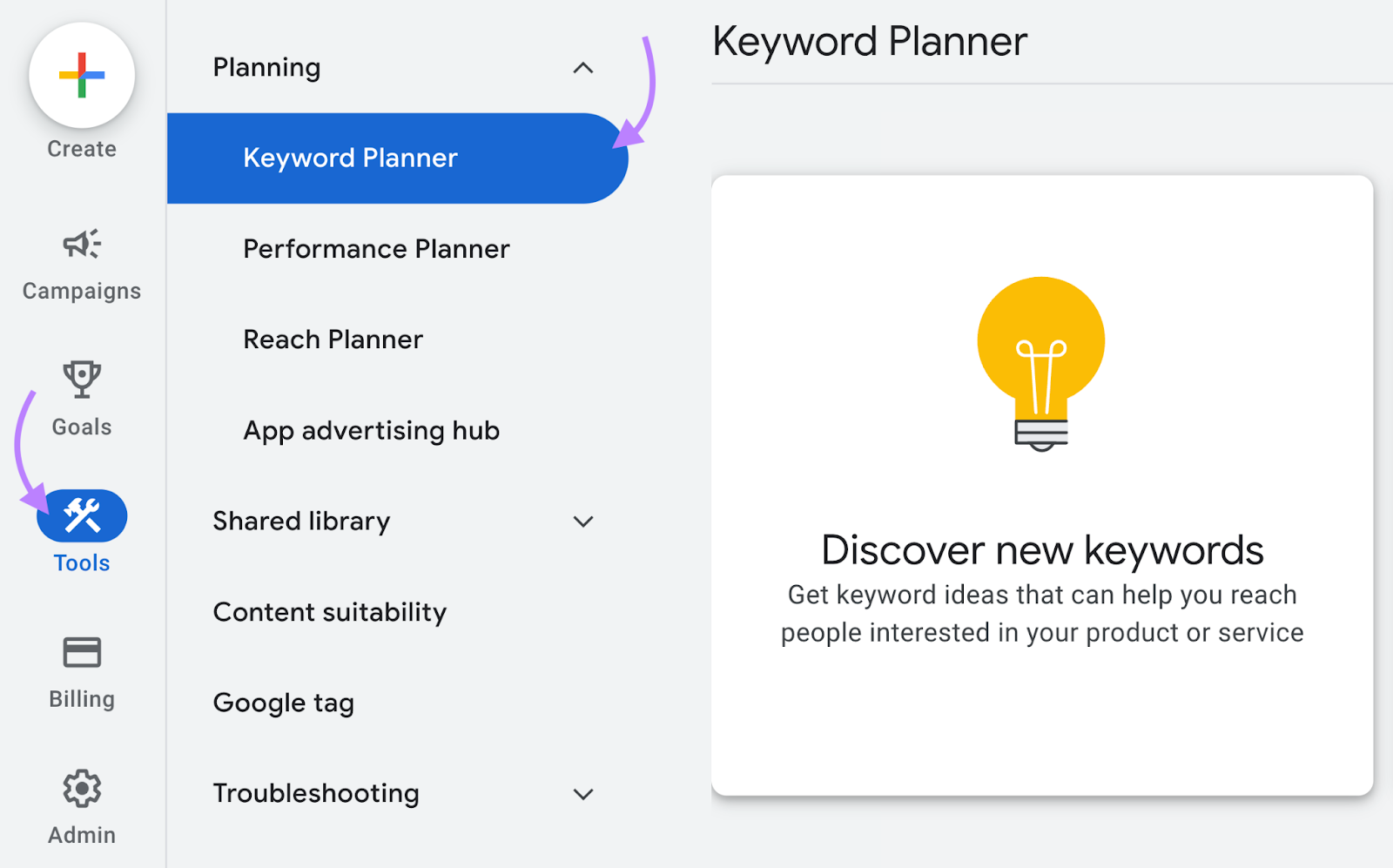
You’ll find two options:
- Discover new keywords: Ideal for finding fresh keyword ideas. Use it when you need to expand your keyword list or are starting from scratch.
- Get search volume and forecasts: Best for analyzing keywords you already have in mind. It provides a list based on your input and forecasts the average CPC.
Let’s say you already have a list of keywords. In this case, click “Get search volume and forecasts.”
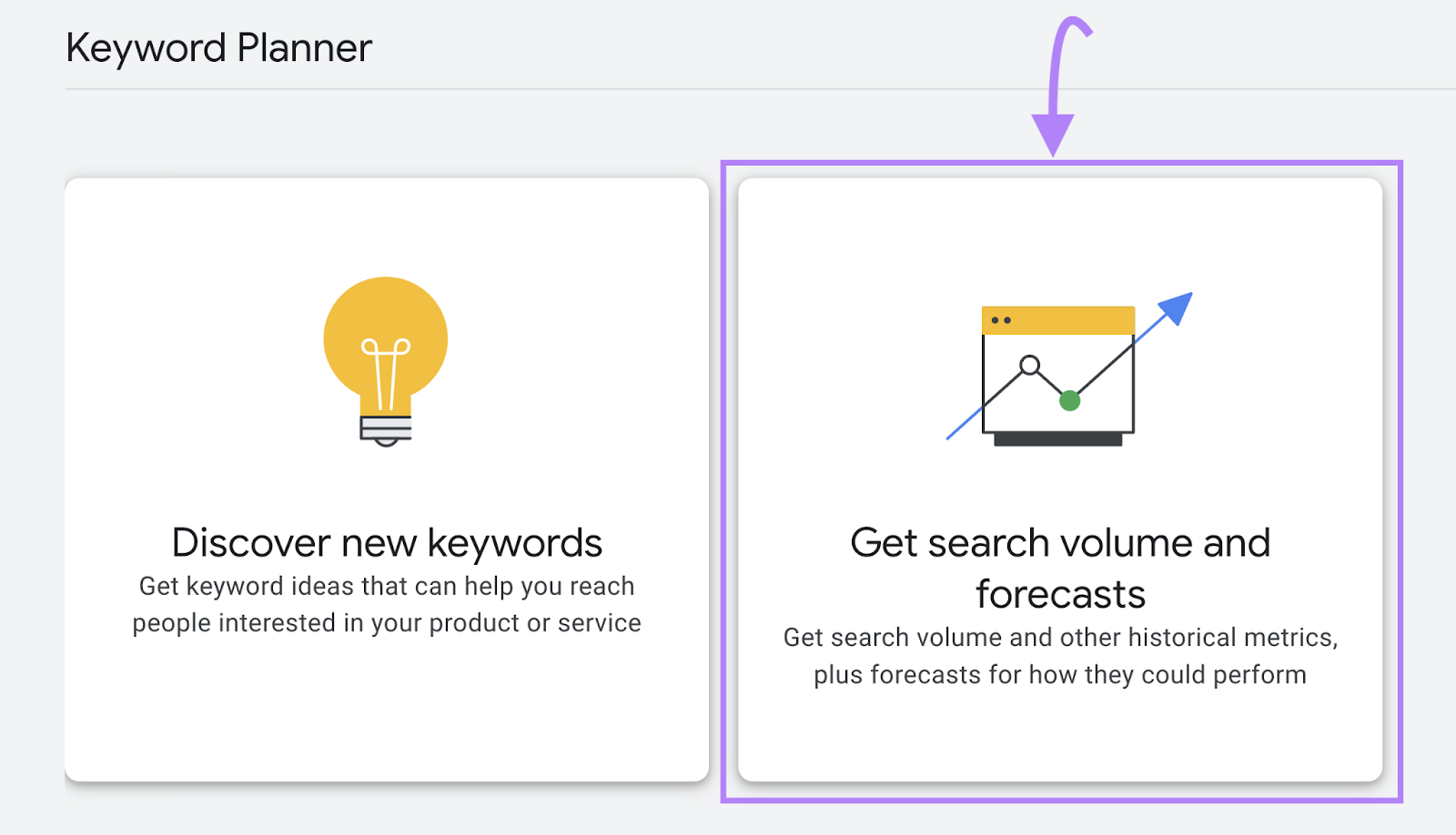
Next, paste your keywords and click “Get started.”
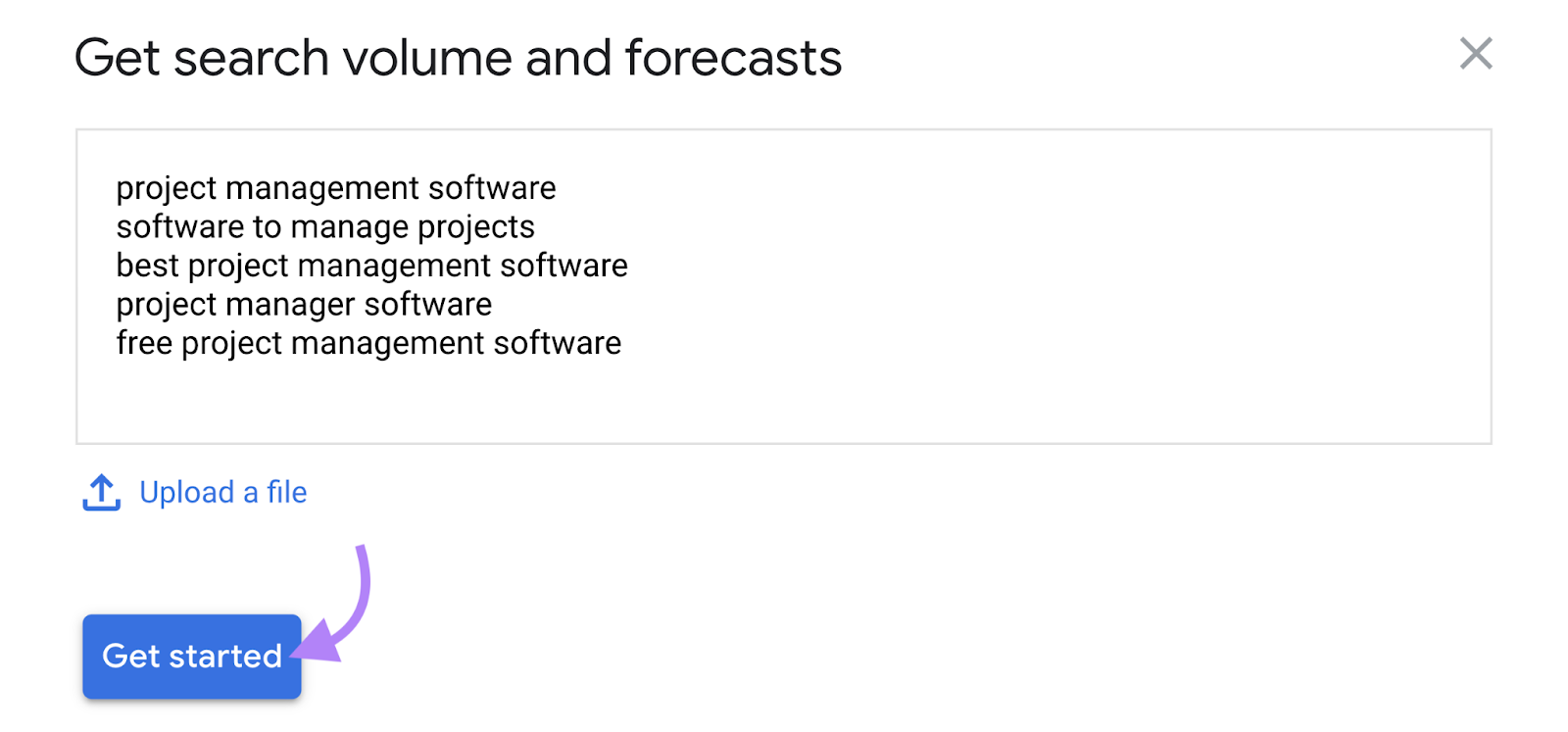
Google Keyword Planner will provide you with insights for each keyword.

The two columns “Top of page bid (low range)” and “Top of page bid (high range)” represent historical lower and upper range estimates for the CPC of that keyword.
Both of these ranges are influenced by your location and your Search Network settings. So, the true cost per click for your keywords is likely to vary from Google Keyword Planner’s estimates.
Now, if you don’t already have a list of keywords, click the “Discover new keywords” option instead.
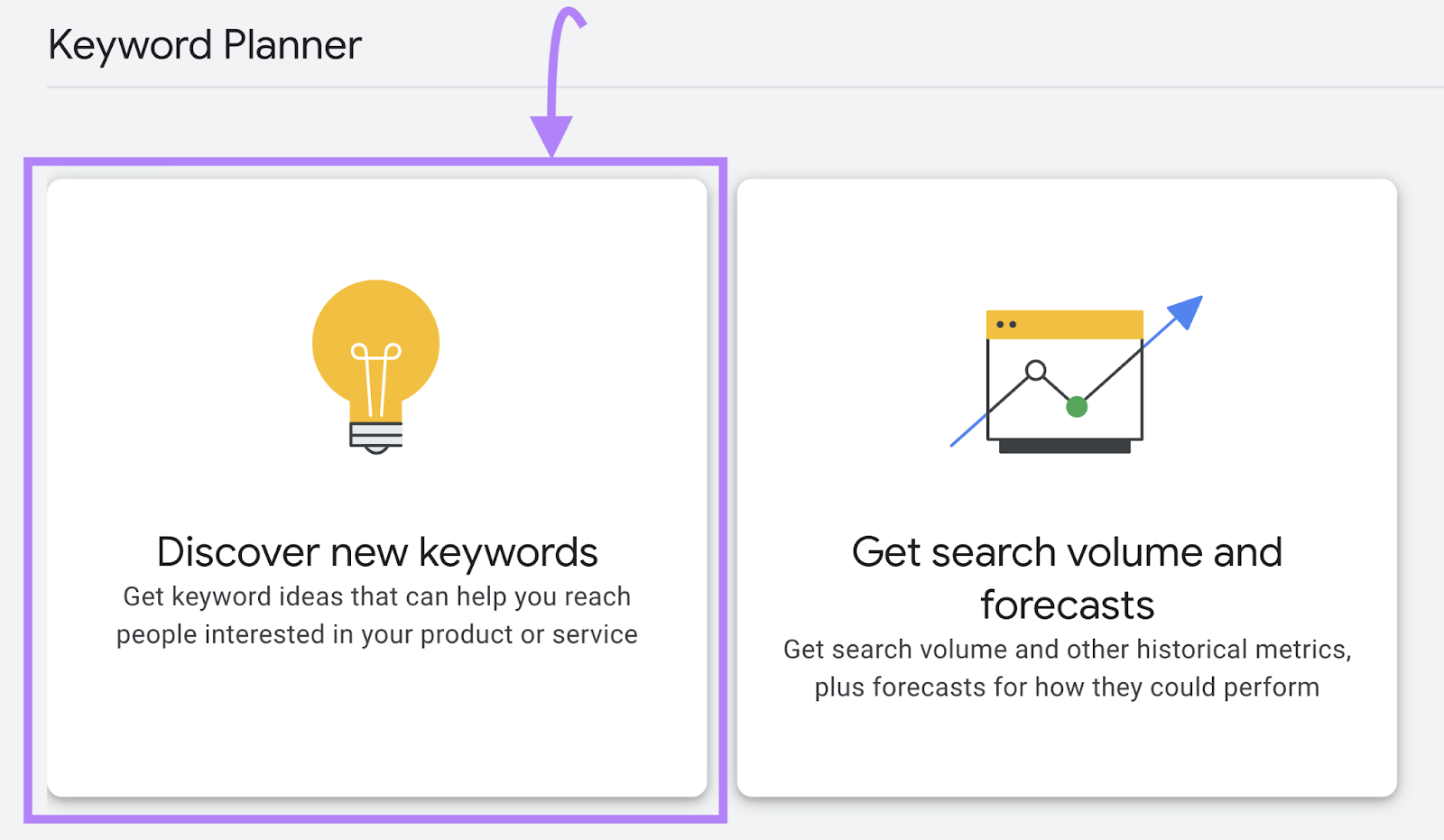
You can discover new keywords in two ways. You can either enter a seed keyword (a broad term related to your business) or a specific URL to see keyword suggestions based on that page.
Let’s go with “Start with keywords.” Enter your seed keyword and click “Get results.”
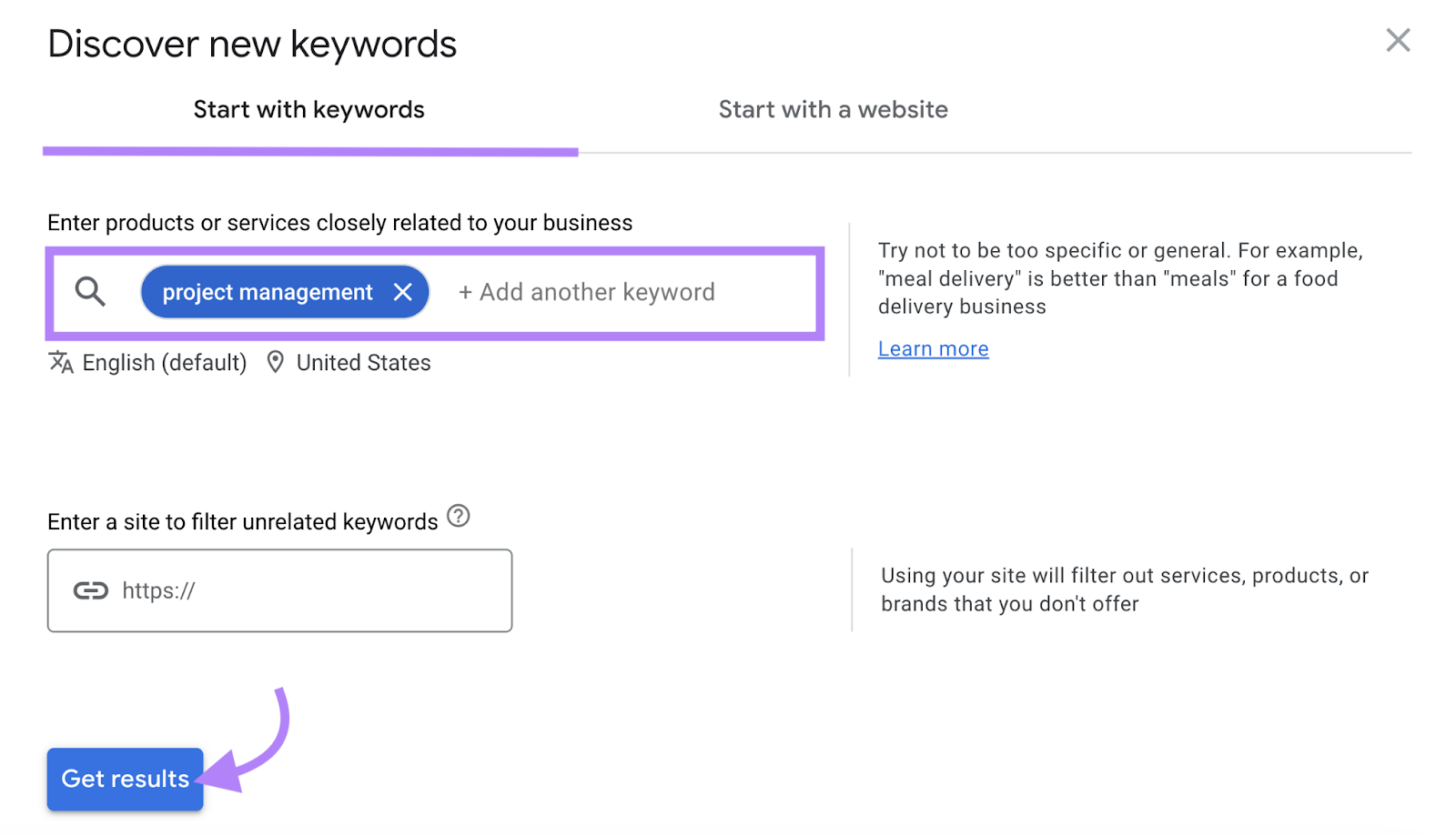
You’ll get a list of keyword suggestions.
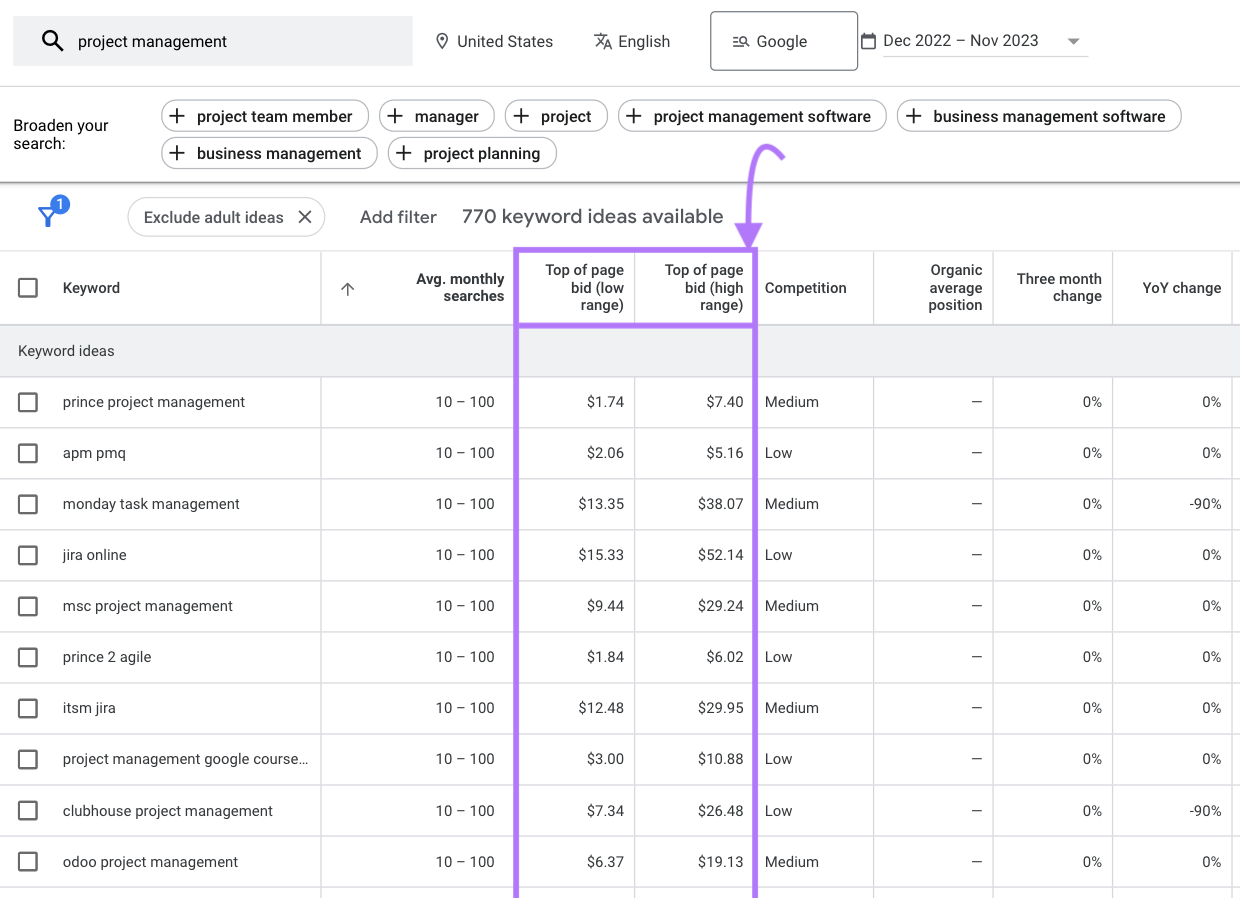
Check out the “Top of page (low range)” and “Top of page bid (high range)” columns.
Analyze these estimates to gauge the potential cost of each keyword.
Keyword Overview
You can also use Semrush’s Keyword Overview tool to find out how much it costs to buy keywords on Google.
The tool gives you the average CPC for keywords and various other data points that can make your campaigns more effective.
To get started, open the tool, enter your keywords (you can add up to 100 keywords), and select your preferred location. Then click “Search.”
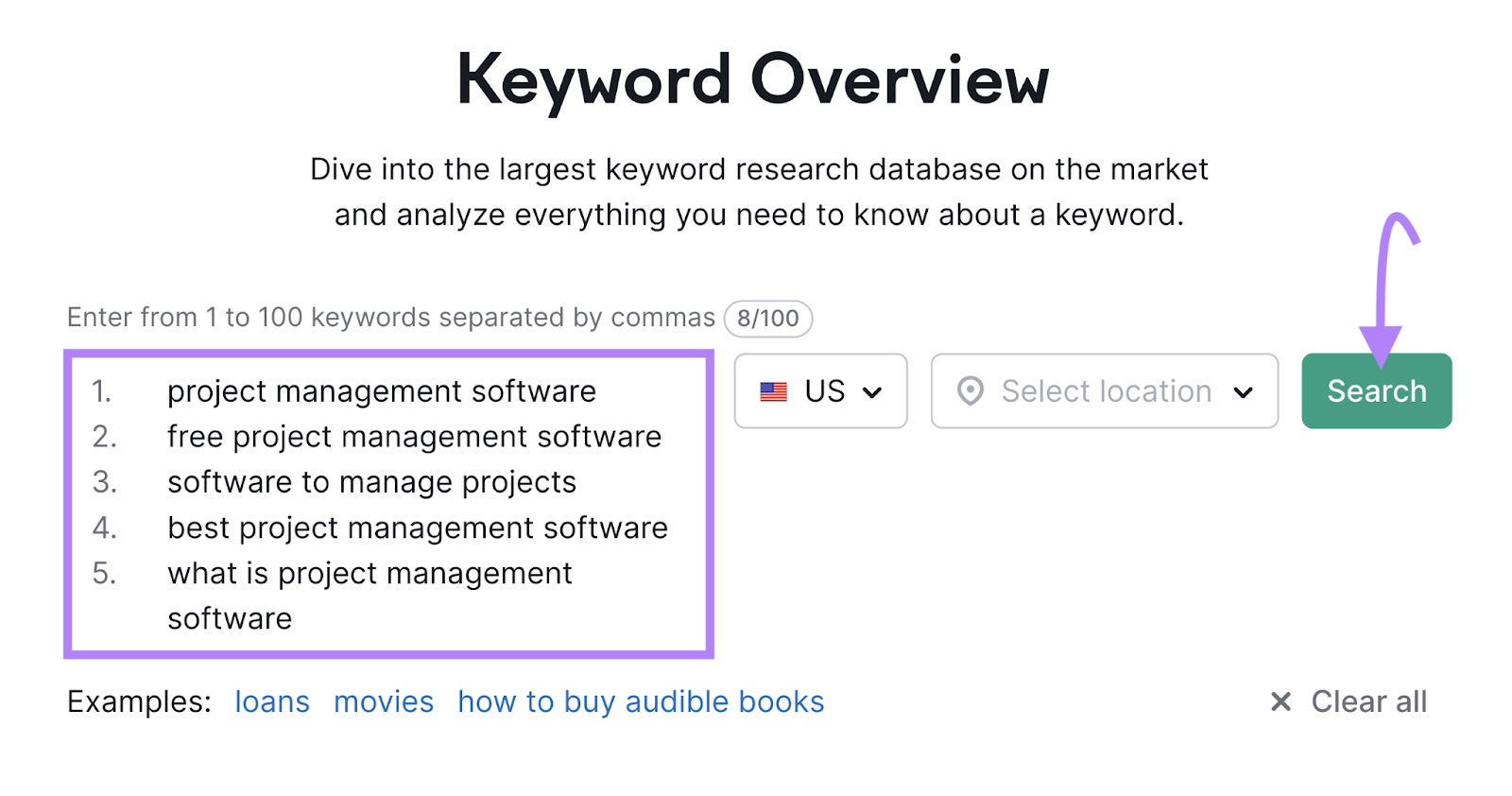
The tool will analyze your keywords and show various insights, including CPC.
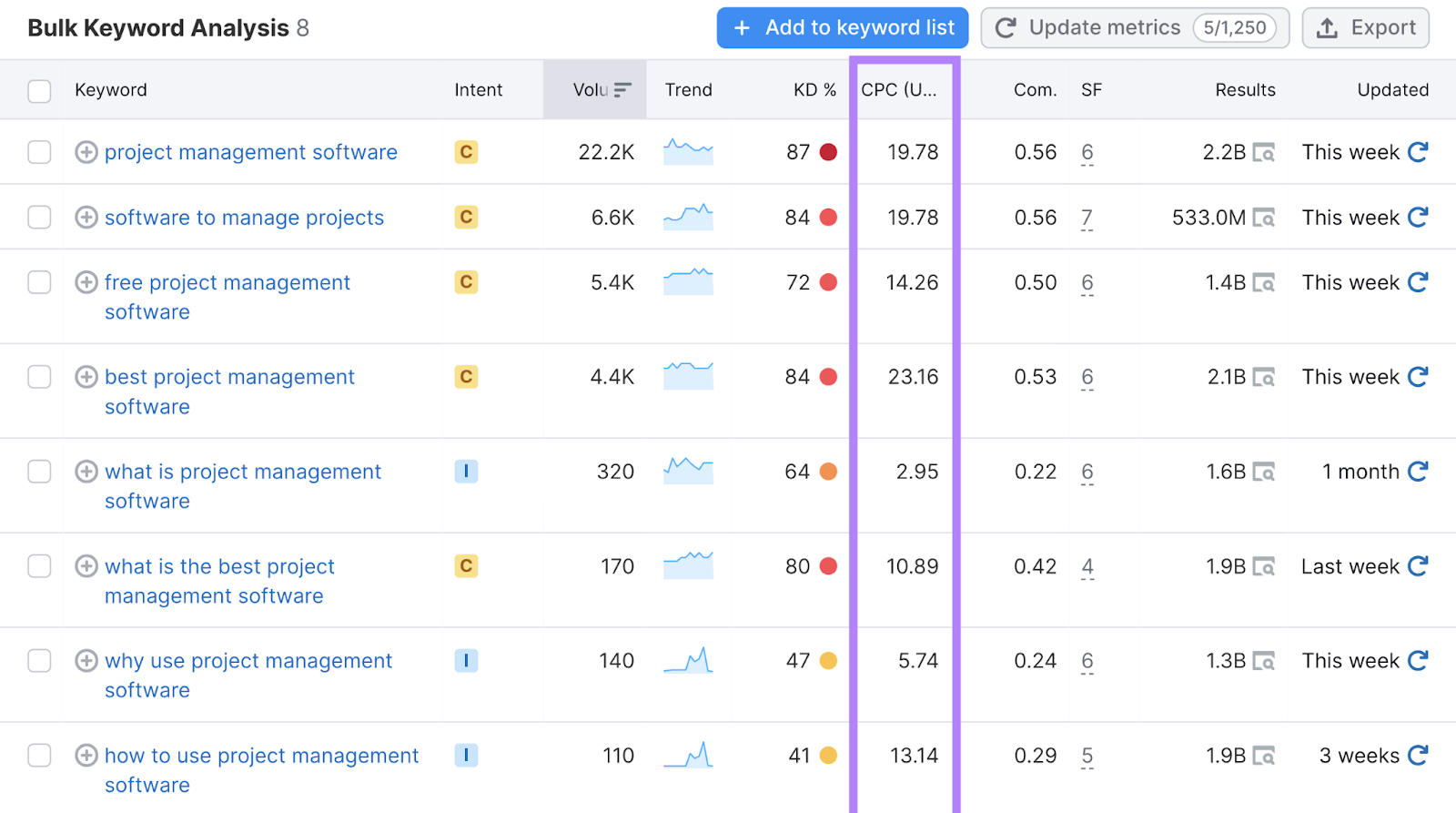
You can sort the keyword list by CPC. To do this, click the “CPC (USD)” column header.
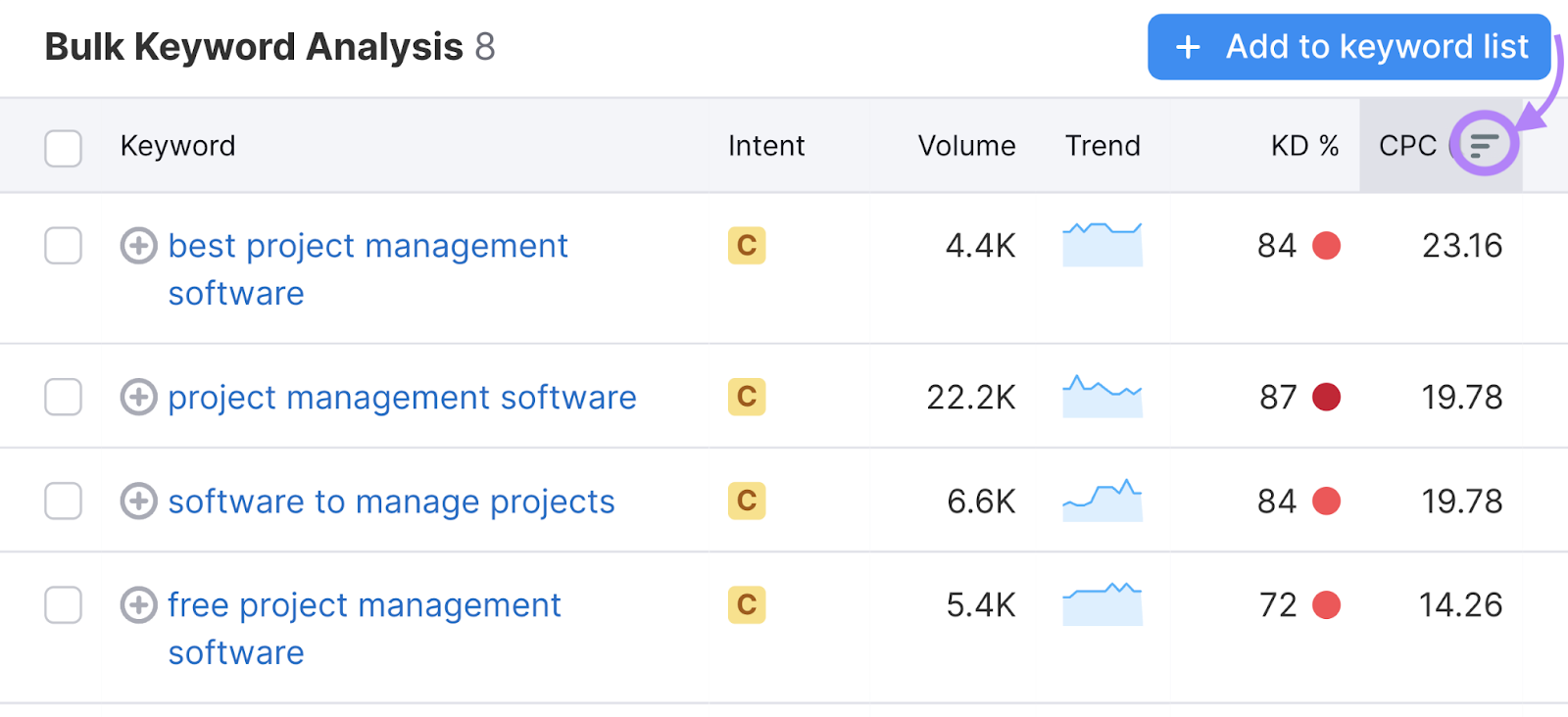
If you don’t already have a list of keywords, you can get started with Semrush’s Keyword Magic Tool. Which will give you keyword suggestions along with useful metrics for each one (including CPC).
Open the tool, enter your seed keyword, and select your preferred location. Then click “Search.”

You’ll see a list of keyword suggestions, along with the average CPC and other useful data points for each keyword.
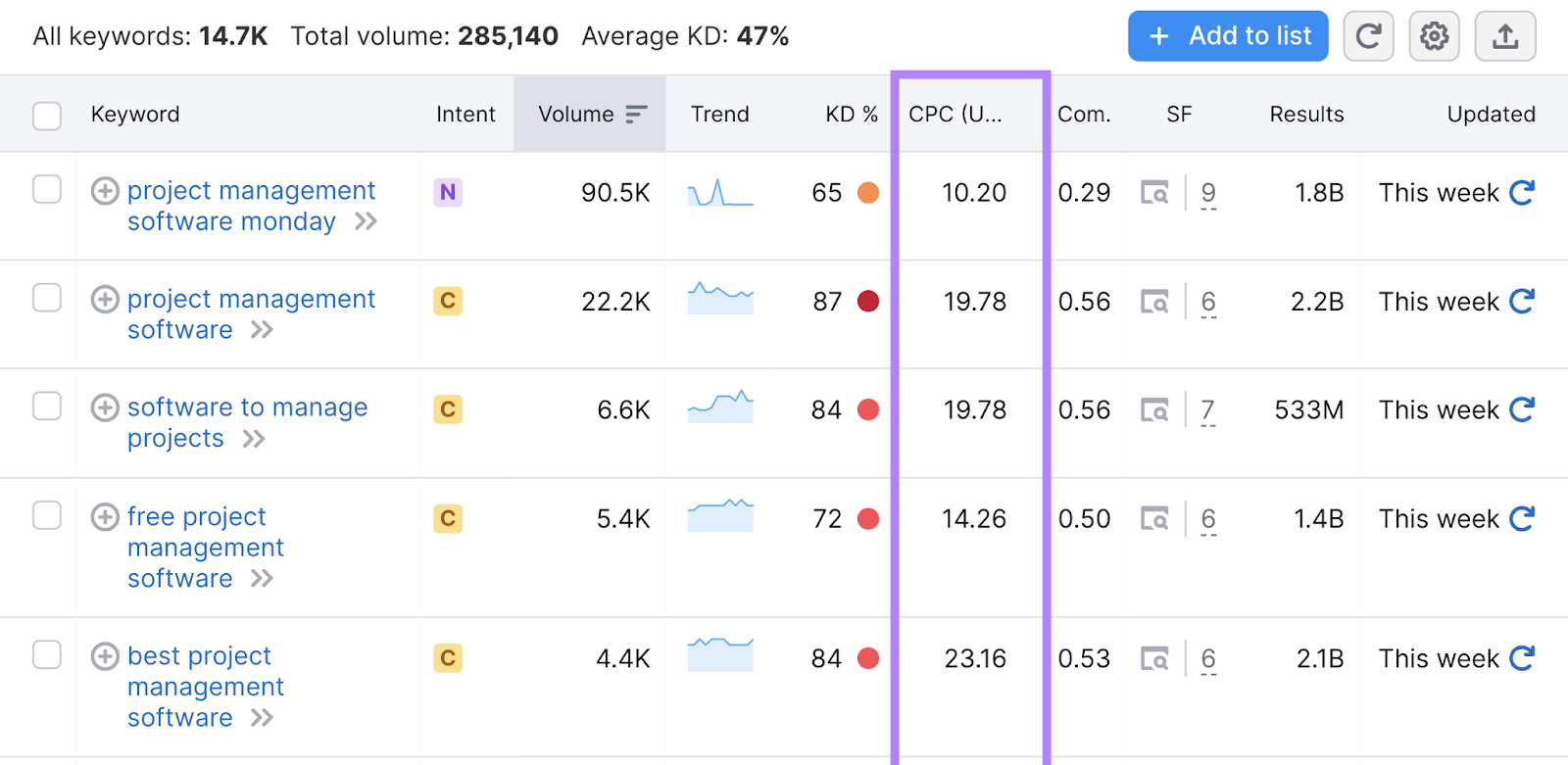
You can filter this result based on the CPC range. This is especially helpful if you have a limited budget. You can set the filter to only show keywords within a specific CPC range.
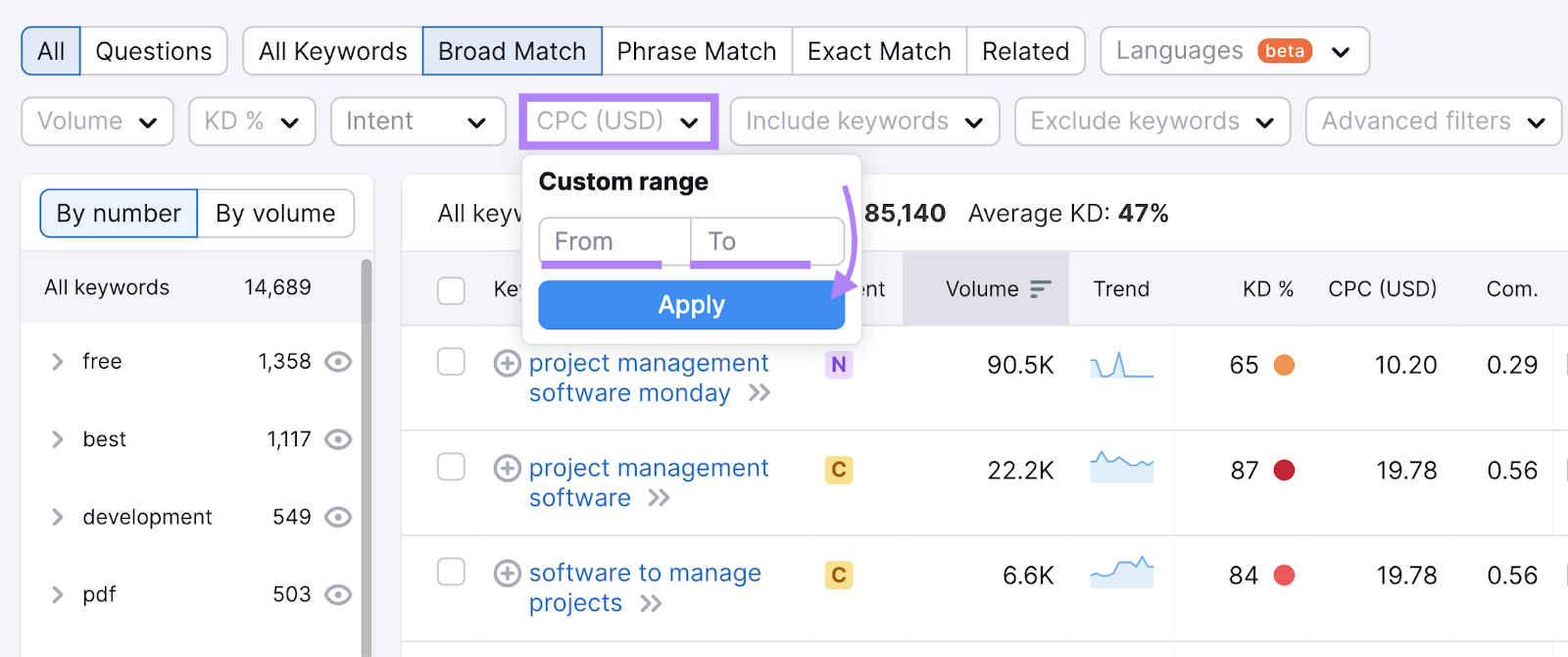
How Does Google Determine Keyword Cost?
Google Ads uses an auction-based system. Advertisers bid on keywords to determine whether their ads will show. This bidding directly affects the cost per click of your target keywords.
To lower your CPC, it’s important to understand the factors that influence it.
Quality Score
Quality Score is a metric Google uses to evaluate your ad’s quality.
Quality Score is based on the expected click-through rate (CTR), the ad’s relevance to the user’s search query, and the relevance and usefulness of the landing page.
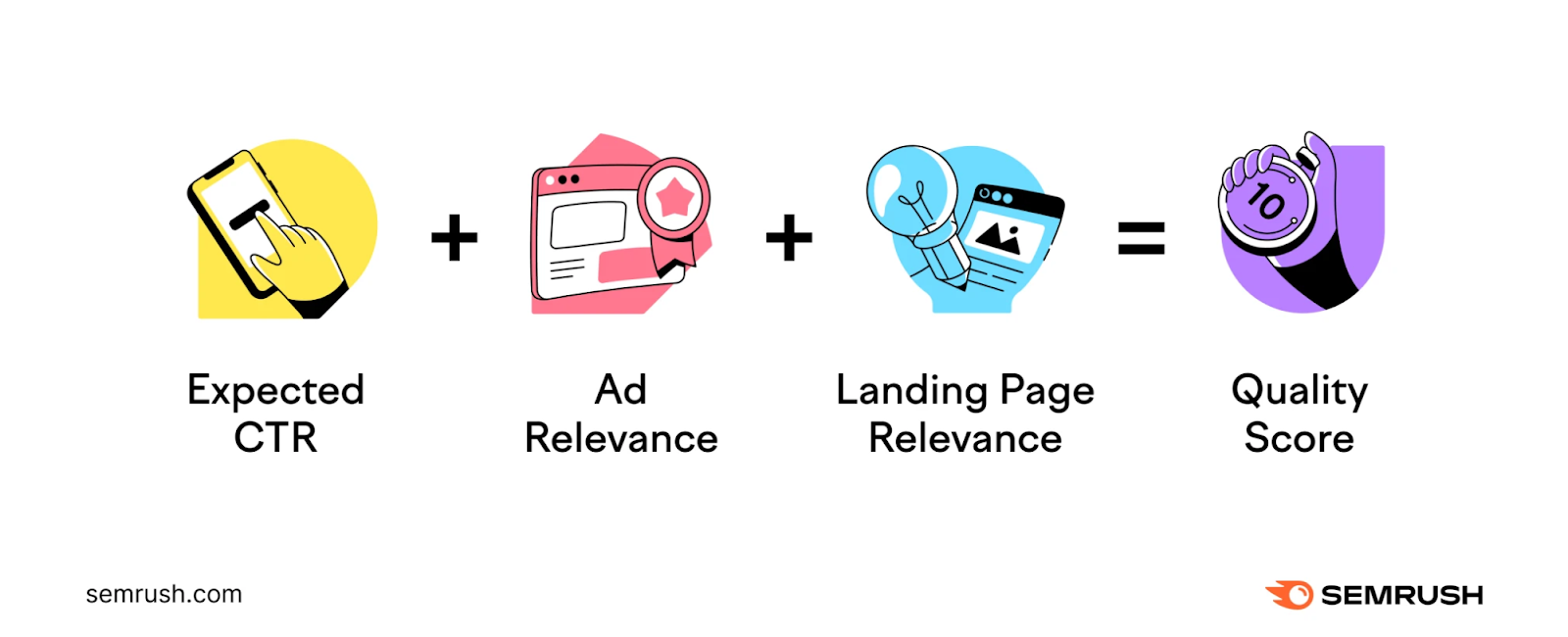
A high Quality Score means Google sees your ad as valuable to searchers’ queries.
Improving your ad’s relevance to the target keyword and enhancing the landing page experience can boost your Quality Score. This can therefore result in a lower CPC.
Level of Competition
The number of advertisers bidding on a keyword determines its competition.
In markets where many advertisers are competing for visibility, the CPC for keywords tends to be higher.
For instance, if you work in real estate in New York, the competition for keywords like “real estate agent New York” is high (as seen in the “Com.” column, which is short for Competitive Density). So, the CPC will also be high.

To manage this, consider getting more specific to your business and targeting less competitive keywords like “commercial real estate agents in New York.”

Further reading: How to Create an Effective PPC Strategy in 7 Steps
Search Volume
Search volume shows how often a keyword is searched over a certain period (usually per month).
Keywords with high search volumes are usually more expensive due to their potential to drive significant traffic, which attracts more bids (increasing competition).
However, high search volume also implies greater visibility and opportunity for brand exposure.
For instance, a company offering CRM software might find high-volume keywords like “CRM software for small business” expensive due to high levels of competition. But these keywords might be highly valuable and worth the higher CPC.

So, when selecting keywords, consider the search volume in relation to the campaign’s goals and budget.
Keyword Relevance
The relevance of your ad to the keywords you’re targeting impacts CPC.
It’s not just about selecting relevant keywords, but also ensuring that your ad text closely matches the search intent of those keywords.
For instance, if your ad is for eco-friendly office supplies, the ad copy should specifically highlight aspects like “sustainable” or “eco-friendly” when targeting keywords like “sustainable office stationery.”
Close alignment between your ad’s text and keyword intent can improve your ad’s performance. And it can lead to a more cost-effective campaign, as it improves the overall ad quality. Which can lead to lower CPCs.
Network Choice
You have two main options when you advertise with Google: the Search Network and the Display Network.
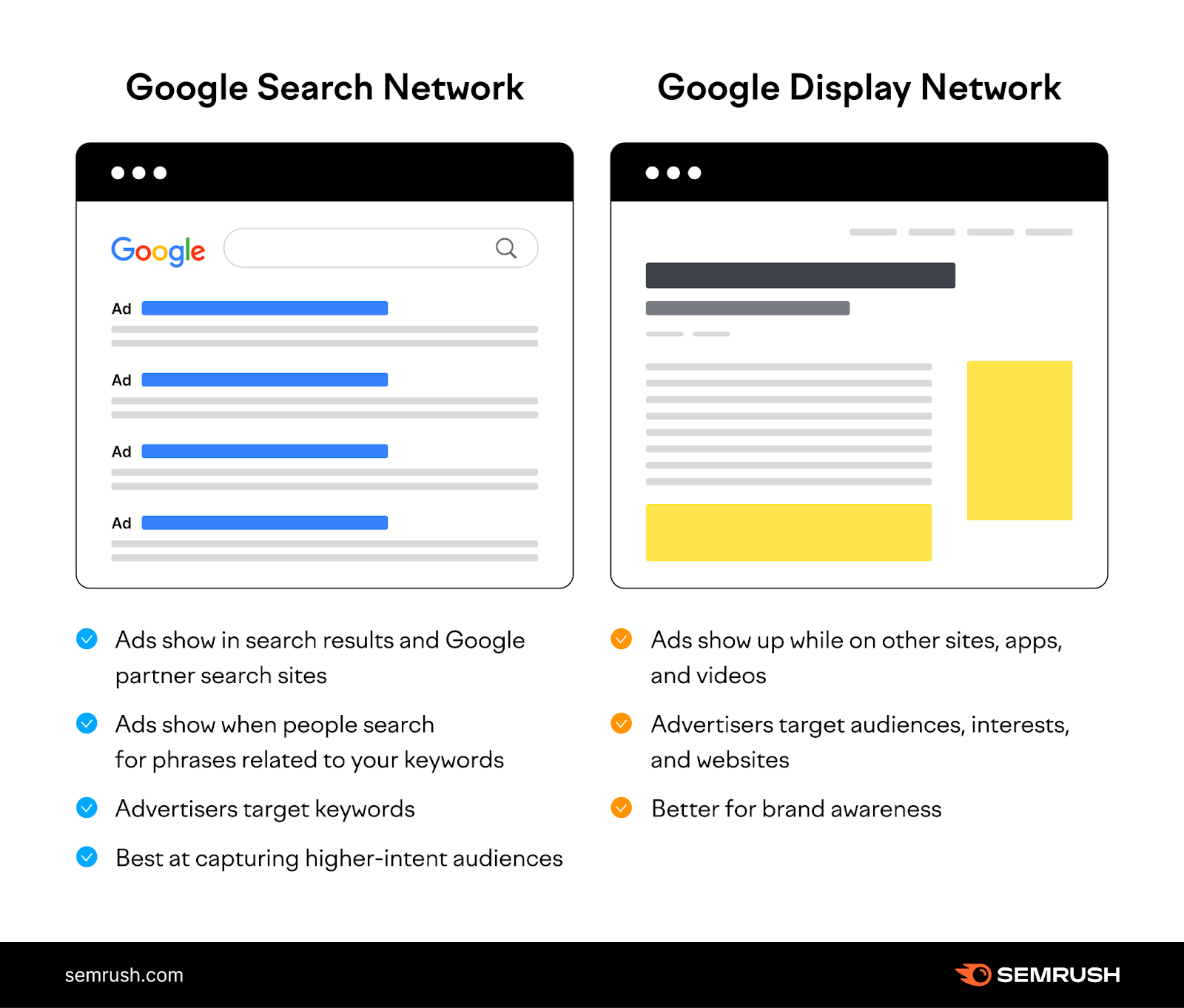
The average CPC on the Search Network is typically higher, but it’s good for reaching people actively looking for what you offer. This is because your ads appear right where people are searching.
On the other hand, the Display Network (which also uses keywords to match ads with related sites) generally has lower costs per click.
This network tends to have lower CPCs partly because it’s more about creating awareness than immediate clicks.
Seasonality and Market Trends
The cost of keywords can fluctuate depending on the time of year or current trends.
For instance, keywords like “Christmas gifts” often become more expensive during the holiday season due to higher demand.
Businesses might bid more on these seasonal keywords to capture the increased search interest, which drives up the cost.
Understanding these patterns is important to plan and budget effectively—especially for industries affected by seasonal trends or specific events.
Bidding Strategy
Google offers two approaches when setting bids for your ads: automated and manual bidding. And this can affect the cost of your keywords.
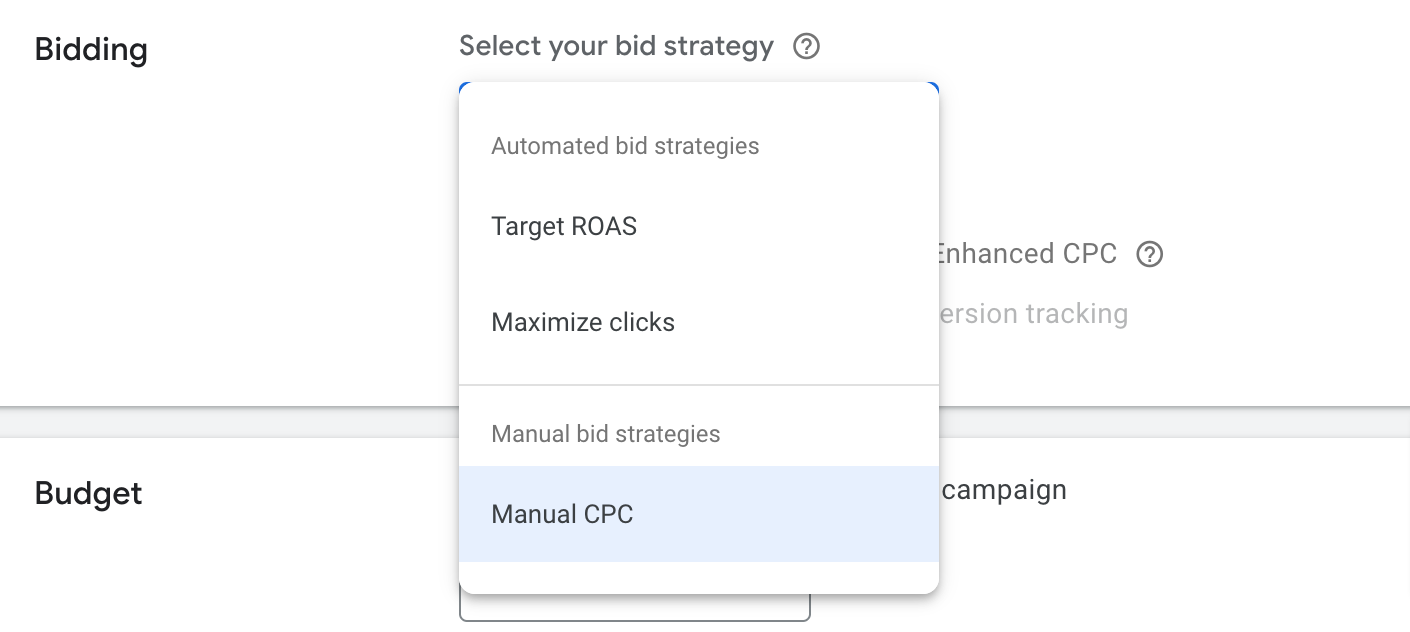
Automated bidding (where Google sets bids for you) can be more expensive. Particularly in competitive markets where optimal bid amounts are constantly changing. However, it’s a time-saver as it adjusts bids automatically to maximize your ad’s performance.
On the other hand, manual bidding gives you direct control over your bids. It requires more attention and adjustment but can be more cost-effective, as it allows you to set limits based on your budget and campaign goals.
How to Pick the Right Keywords for Your Ads
Choosing the right keywords for PPC ad campaigns involves strategically weighing factors like relevance, competition, and cost. You want to pick keywords that are relevant to your business, but also ideally with lower costs per click.
Here are a few factors you should consider when picking keywords for your ad campaign:
What Keywords Are Your Competitors Targeting?
If your competitors share the same target audience as your business, it’s a good idea to analyze and learn from their ad campaigns.
You can use Semrush’s Advertising Research tool for this.
Open the tool, enter your competitor’s domain, and click “Search.”

You’ll see an overview of the total number of paid keywords driving traffic to your competitor’s site.
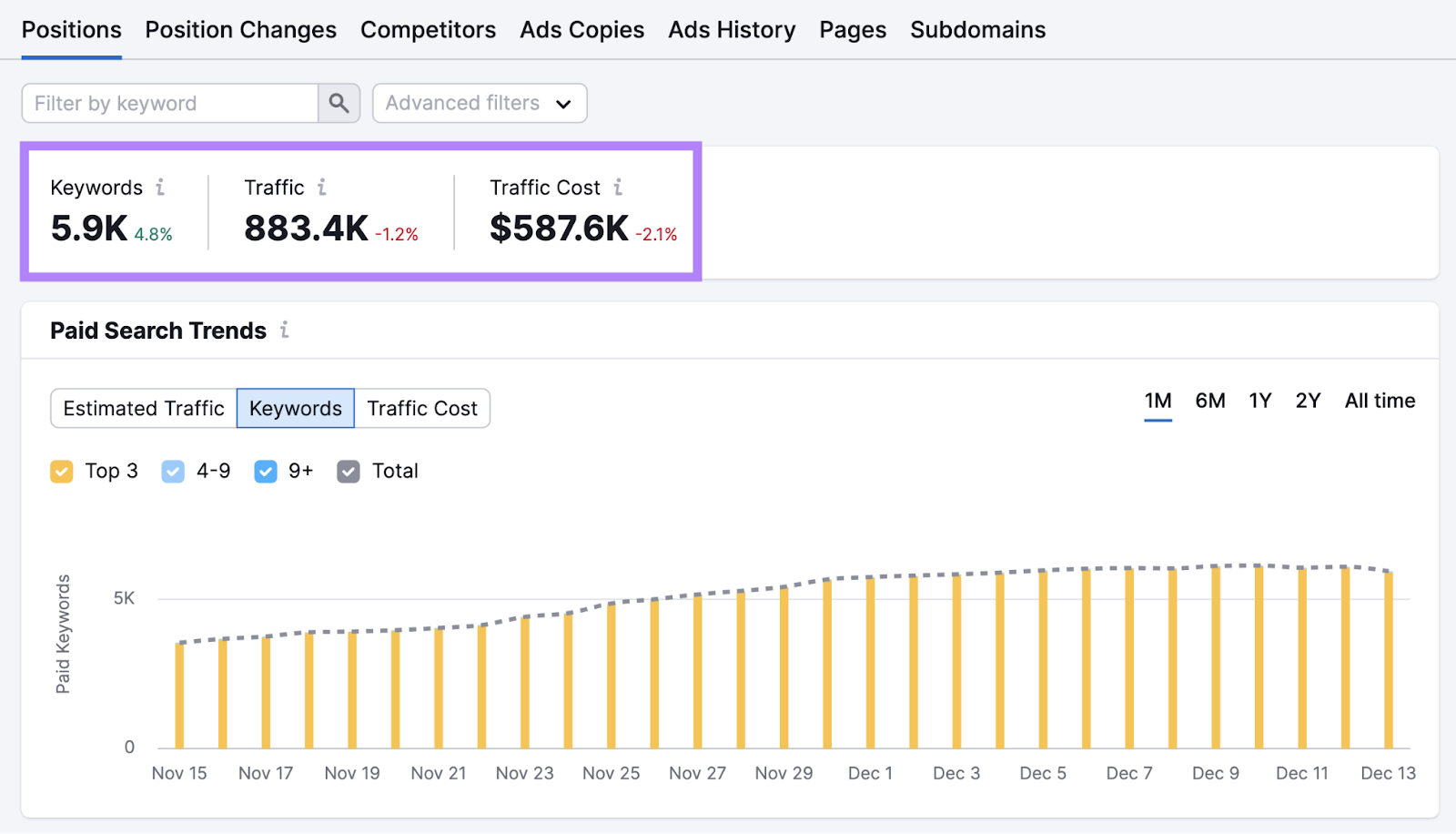
Scroll down to the “Paid Search Positions” section. This is where you’ll find the keywords that bring users to the domain via paid search ads.
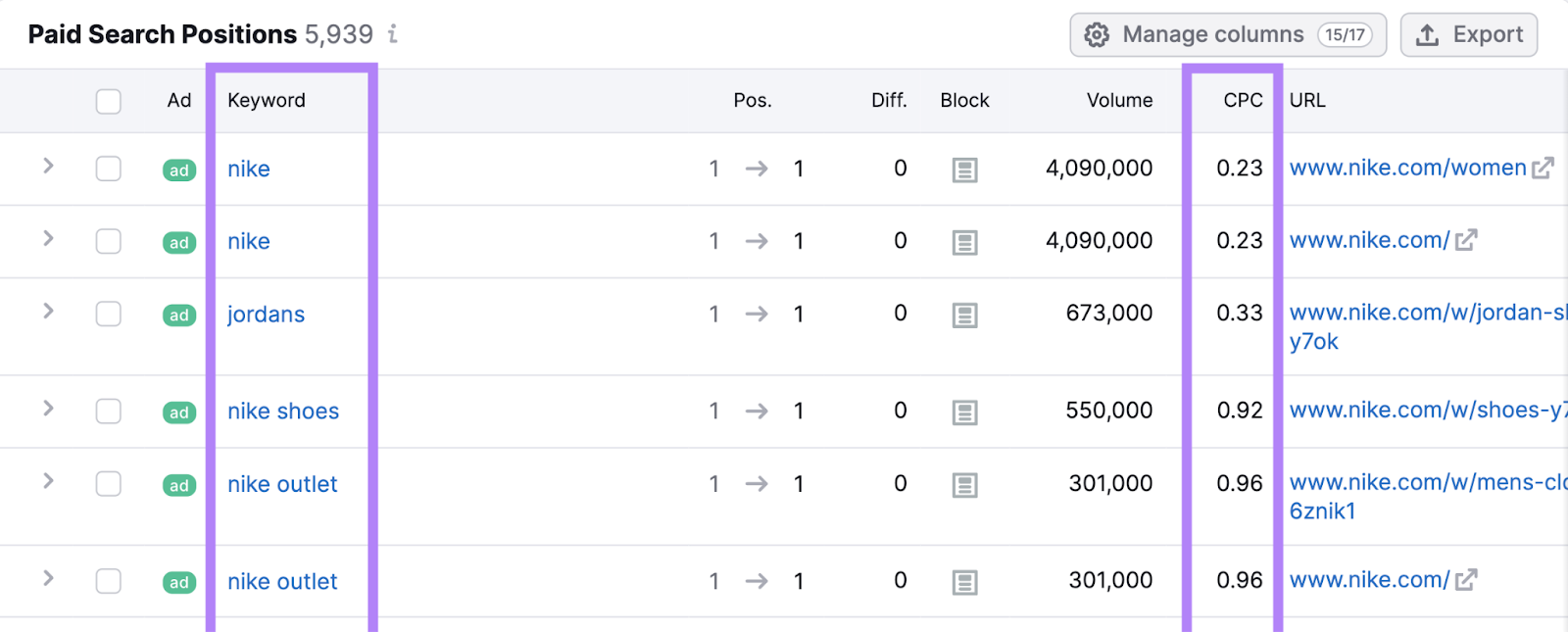
Go through the keywords and select the ones for your own campaign that are relevant to your business and (ideally) have a low CPC.
Next, go to the “Ads Copies” tab. Here, you’ll see the ad copy your competitor is using for different paid keywords.
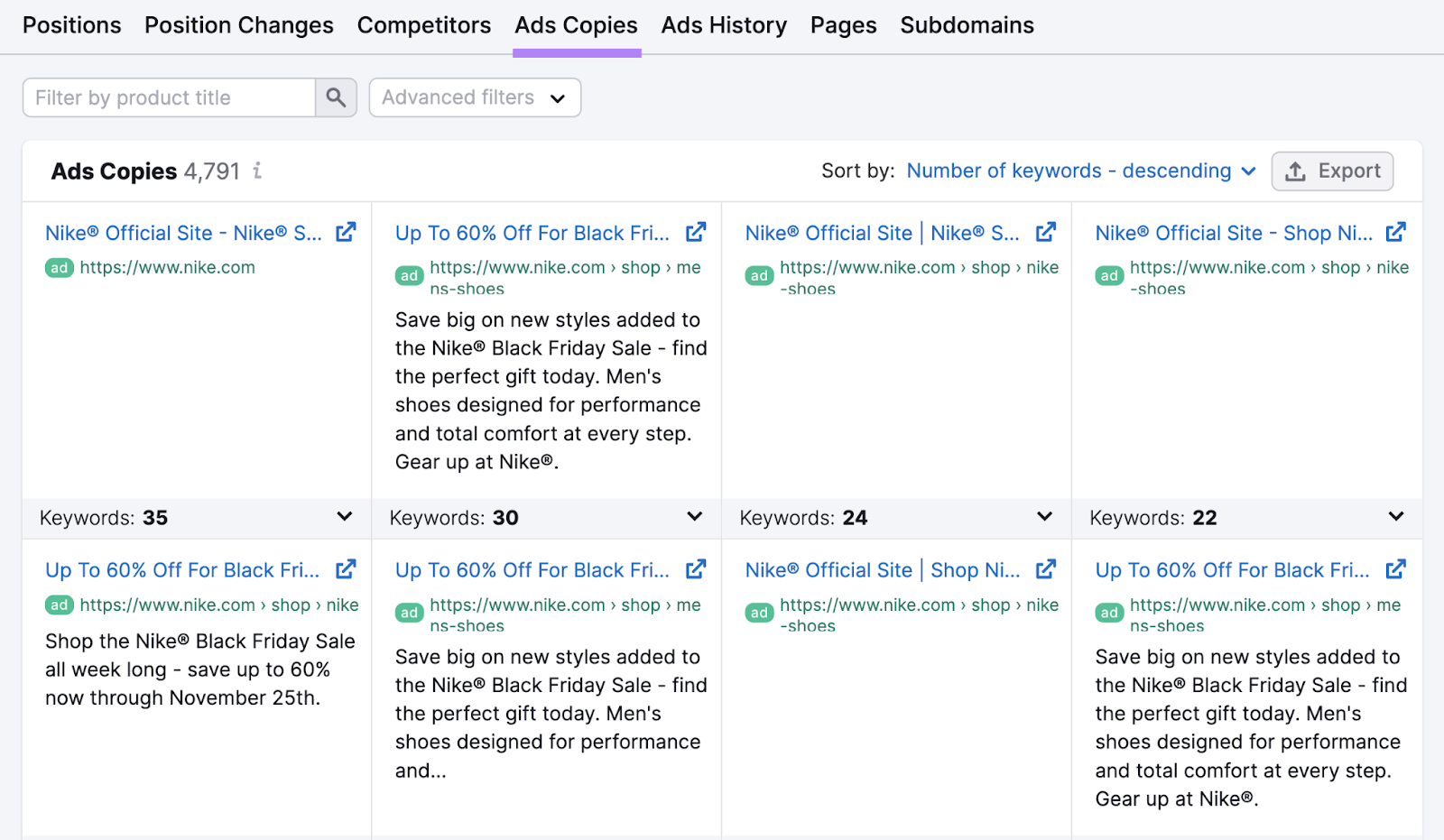
Looking at your competitor’s ad copy can help you create better messaging for your own campaigns.
Is the Keyword Relevant to Your Product?
Choose keywords that are closely related to your products. This ensures your ads appear in relevant searches. Which increases the chance of clicks and conversions.
For example, if you sell eco-friendly water bottles, your keywords might include “reusable water bottles” or “eco-friendly hydration” and not something like “cheap plastic water bottles,” which might be less relevant to what you actually offer.
Keyword match types are rules that control how closely the keyword needs to match with users’ search queries for your ad to show.
Broad-match keywords can trigger your ads for queries that are not actually relevant to your product. Whereas exact-match keywords will trigger your ads for search queries that are more relevant to your product.
Generally, you want to avoid broad-match keyword ideas for ad campaigns. They can be useful for wider reach, but they’re less targeted than exact match or partial/phrase match keywords.
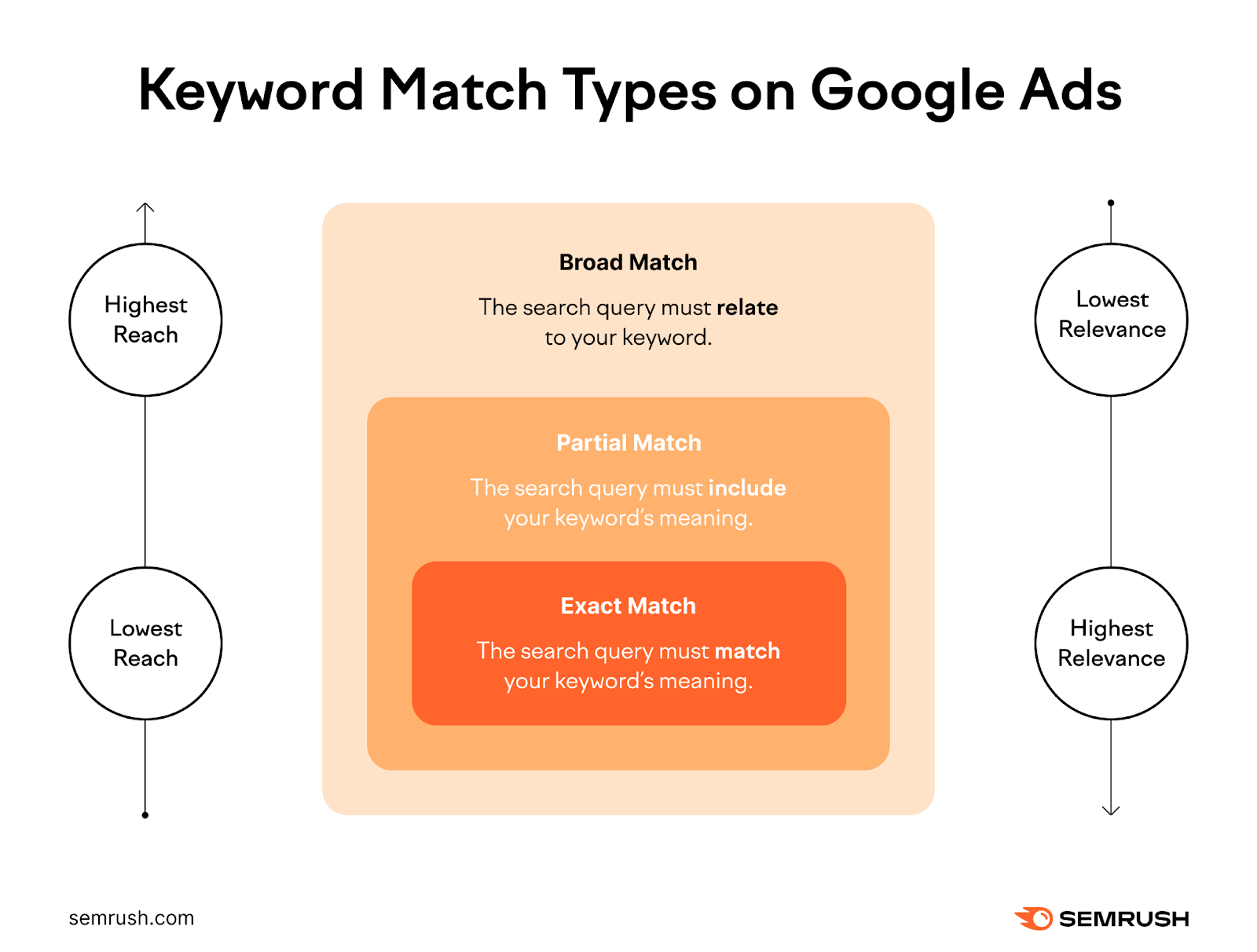
Is the Keyword Profitable?
High-cost, popular keywords might bring traffic. But they’re only worth it if they convert well.
Analyze the cost against the potential return on investment (ROI).
To evaluate whether a high-cost keyword is worth it, you can run a small trial campaign using that keyword in Google Ads.
Track how many sales or inquiries it brings compared to how much it costs to target.
For instance, if you’re considering the keyword “luxury yoga retreats,” check if the bookings you receive from the ads justify the higher cost of the keyword.
If not, consider targeting a more specific keyword to see if it yields better ROI. You can then use these insights to scale up your advertising efforts.
Is It a Long-Tail Keyword?
Long-tail keywords are more specific phrases with lower competition. They attract a more targeted audience, which can lead to higher conversion rates.
For example, if you’re selling specialized footwear, instead of targeting “shoes,” focus on keywords like “waterproof hiking boots for women” or “men’s lightweight trail running shoes.” Just make sure they’re relevant to your products and ads.
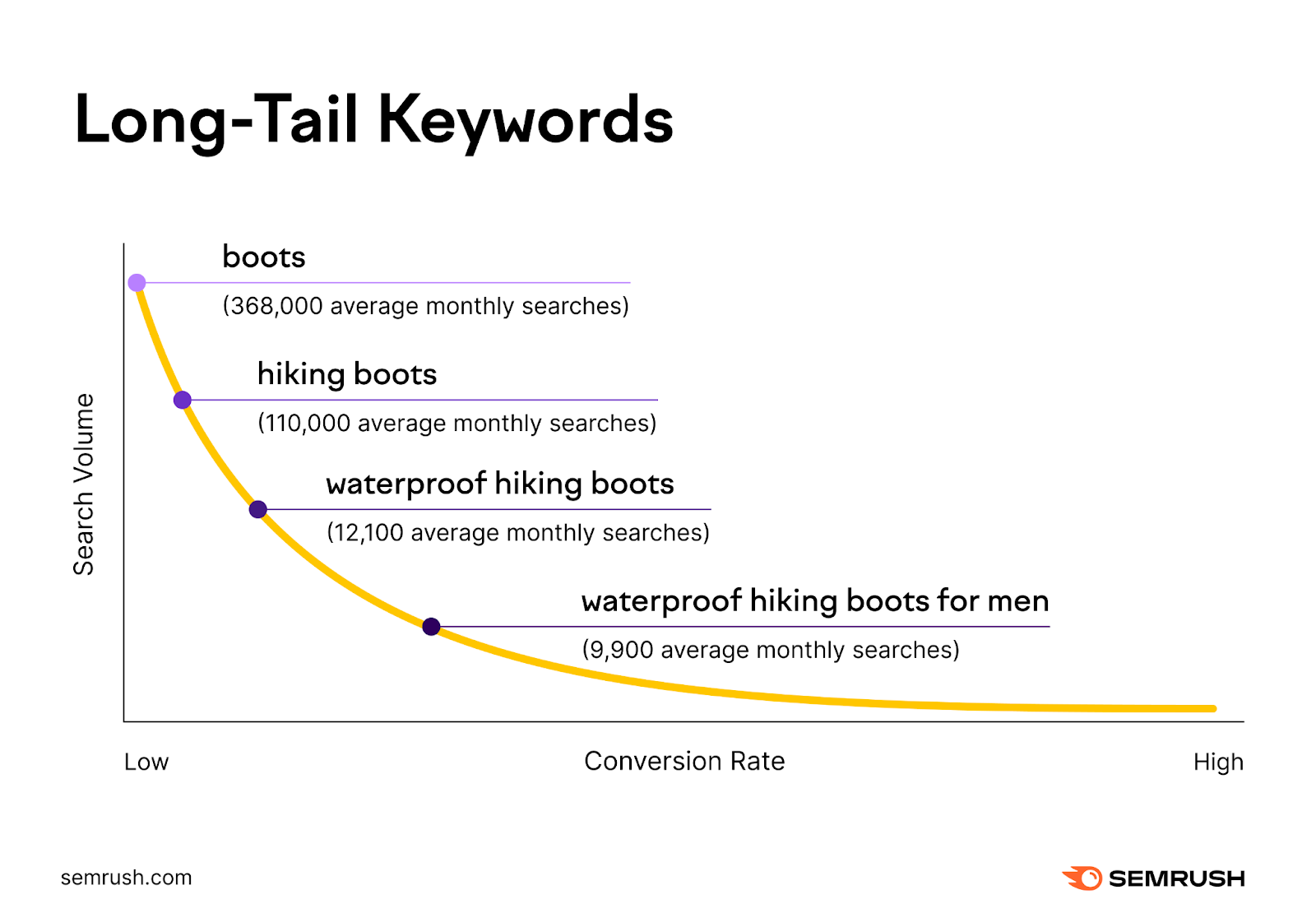
These long-tail keywords may better represent what your potential customers are looking for.
This targeted approach means you’re advertising to buyers already interested in your specific offering, increasing the chances of a sale. However, they usually have lower search volumes, which you need to factor into your overall advertising strategy.
Are You Testing (and Refining) the Campaign?
Regularly check how well your keywords are performing. If certain keywords aren’t attracting clicks or conversions, replace them, and monitor how the new ones perform.
Keyword selection is not a one-time task. Experiment with different phrases to see which ones resonate the most with your target audience.
For example, if “organic coffee beans” isn’t performing well, try “freshly roasted organic coffee” and compare the results.
This ongoing process helps refine your strategy, ensuring it stays effective over time.
Further reading: How to Do PPC Keyword Research for Profitable CPC Campaigns
Ready to Find Low-Cost, High-Value Keywords?
Keyword cost is just one factor to consider when choosing which ones to target in your ad campaigns.
Remember: You can end up paying less than the average CPC if other aspects of your campaign are well-optimized. Like creating a landing page that delivers a good user experience and crafting ad copy relevant to users’ search intent.
You also want to choose relevant keywords with reasonable search volume and low competition.
You can do this with ease using the Semrush Keyword Magic Tool. Get started today for free.
Source link : Semrush.com
